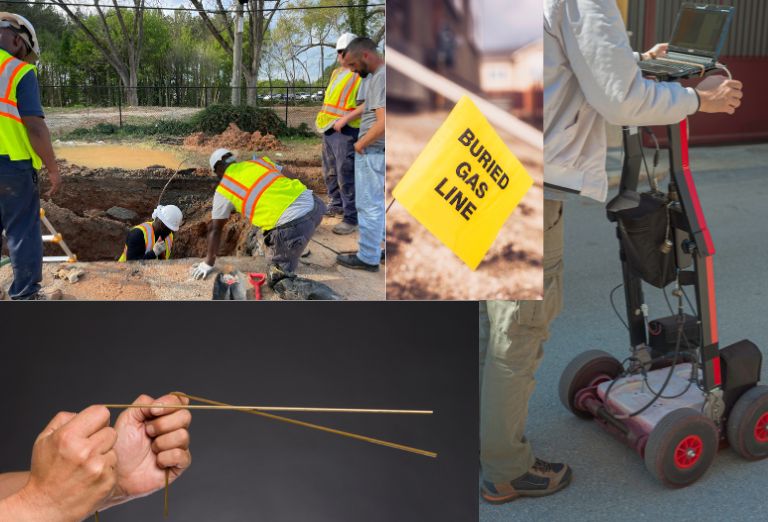What are the common underground utility location methods?
Underground utility location is a critical safety practice that prevents costly damage, service disruptions, and dangerous accidents. Each year, billions of dollars are spent addressing utility strikes caused by excavation errors. Selecting the right locating method determines project success.
Let’s explore five effective utility location techniques used by professionals today.
1. Electromagnetic Utility Locating: The Industry Standard
Electromagnetic utility locating is the most common method for detecting underground utilities. It uses electromagnetic radio frequencies to identify subsurface utilities containing conductive materials.
- Equipment generates electromagnetic signals
- Signals travel through conductive utility components
- Receivers detect and map buried line locations
Detects:
- Natural gas lines (with tracer wire)
- Electrical cables
- Telephone and cable lines
- Water and sewer lines
- Irrigation systems
Limitations: This method cannot detect non-conductive materials like plastic, asbestos, concrete, or terra-cotta pipes unless they contain conductive elements such as tracer wire. Polyethylene gas lines are only locatable if tracer wire is installed alongside the pipeline.
Depth Capabilities: Effective up to 10–15 feet below the surface. Natural gas distribution lines are typically buried 3–4 feet deep, with transmission lines deeper yet, usually less than 10 feet.
2. Ground Penetrating Radar (GPR): Advanced Detection Technology
Ground-penetrating radar uses high-frequency radio waves to generate detailed subsurface imagery. When the waves hit buried objects, they reflect back to the receiver, creating a visual representation of underground features.
Best For:
- Non-conductive pipes and tanks
- Concrete or ceramic utilities
- Underground storage tanks
- Congested utility areas
Key Limitations:
- Soil type: Performance decreases in clay, shale, or saline soils
- Target size: Buried objects must be roughly one inch in diameter per foot of depth
- Operator skill: Accurate interpretation requires extensive training
Pro Tip: GPR performs best in sandy soils and loses effectiveness in high-conductivity environments.
3. Vacuum and Hydro Excavation: Precision Exposure Methods
Potholing, also known as soft digging, is a method that safely exposes utilities with a lower damage risk.
Vacuum Excavation:
- High-pressure air loosens soil
- Debris vacuumed into containment tank
- Best for stable soil conditions
Hydro Excavation:
- Pressurized water breaks up soil
- Material removed via vacuum system
- Ideal for difficult or frozen soils
Advantages:
- Zero risk of utility damage
- Pinpoint accuracy for depth and location
- Works in all soil types
4. Acoustic Location: Detecting Active Systems
Acoustic methods detect sound frequencies generated by active utility systems, especially from those under pressure or experiencing leaks.
Common Uses:
- Gas leak detection
- Water line breaks
- Pressurized system mapping
- Active pipeline monitoring
This method works best when systems are pressurized or leaking, as they generate distinct sound-based signatures.
5. Traditional Dowsing: Experience Meets Intuition
Though not scientifically substantiated, many seasoned locators report success using dowsing techniques with metal rods—often repurposed coat hangers—to detect buried utilities.
Important Notes:
- Cannot determine depth
- Relies heavily on operator intuition
- Should only supplement other methods
- Effectiveness varies widely
Historical Context: Dowsing has been used since medieval times to locate water and other subsurface features, though its effectiveness remains debated.
Choosing the Right Method for Your Project
For Natural Gas Lines:
- Start with electromagnetic locating (if tracer wire present)
- Use GPR for non-conductive pipes
- Confirm with vacuum or hydro excavation
For Multiple Utility Detection:
- Combine electromagnetic and GPR methods
- Verify locations with potholing
For Challenging Conditions:
- Begin with hydro excavation
- Use acoustic methods for pressurized systems
Safety First: Professional Standards and Best Practices
Never begin excavation without properly locating all utilities. Follow these safety steps:
- Call 811: Always notify your local utility marking service
- Wait for markings: Allow time for utilities to be identified and marked
- Verify: Use multiple detection methods when possible
- Document: Keep clear records of utility locations
- Excavate carefully: Hand dig within marked tolerance zones
The Importance of Tracer Wire in Gas Systems
Polyethylene gas lines require tracer wire for electromagnetic detection. This tracer wire when installed alongside or above the pipeline, creates the conductive path needed for standard locating equipment.
Tracer Wire Benefits:
- Enables detection of plastic gas lines
- Provides continuous location access
- Aids long-term maintenance
- Meets safety standards
Upgrade to German Engineered Utility Location Precision
Sewerin UtiliTrac & UT Series Pipe/Cable Locators Now Available Through Linc Energy Systems
- Folding UtiliTrac design with 3D compass display—under 16 lbs total
- UT 9200/9100/930 series with 30-hour operation and GPS integration
- Glass fiber probe system for plastic pipe detection
- Intelligent frequency scanning and direction recognition
Why Choose Sewerin Through Linc Energy Systems:
- German engineering with local US support
- Comprehensive training and technical expertise
- Seamless integration with existing location methods
- 30+ years of utility industry experience
Schedule Your Sewerin Demo | Call 303.697.6701
Conclusion
Effective underground utility location combines proven methods with professional expertise. While electromagnetic locating is the industry standard, successful projects often require the use of multiple techniques for comprehensive detection.
Whether installing new gas lines, maintaining existing infrastructure, or planning construction, proper utility location protects both people and property. Prevention costs of professional locating services and quality equipment are less than the cost of a utility hit and repair.





What is methodology of utility identifiation
ProMark Utility Supply manufactures different types of underground locating posts such as CP Test Stations.
Hi Susan Bender !
I need to look for the pipe at depth of 20 … 27 m.
Length of the pipe 300 … 600 m
It is located under the ground.
Pipe diameter of 7 feet.
Material – steel + concrete.
Which device is suitable?
Compass is suitable or not?
If appropriate, what?
Thank you
Evgeny Dron
A member of our customer service team will be emailing within 24 hours.
It’s amazing what technology can do nowadays. Electromagnetic radio waves can be used to find metal lines underground, and sound waves can find what electromagnetic waves can’t. It’s important to know where utilities are underground when digging to prevent pipe breakages, and these technologies allow us to do so with ease. Thanks for all the information about different methods to find underground utilities!
Your blog is much effective and thanks for sharing information.. Here We are providing underground water detector products, water sensor detectors, ground water detection machines work in all soil conditions on earth.
ground water detection machine
water detector
deep search water finder
long range water detector
advanced deep water finder
wholesale long range gold detector
worlds best metal detector
diamond detector machine
my wife was looking for DD 2400 recently and discovered a company that hosts lots of form templates . If you have been needing DD 2400
Hello there, Susan or anybody.
PLEASE HELP
I’m facing a similar challenge as Evgeny Dron. I need to find a tunnel with old utilities and it is about 80 feet underground. I need to get a clear picture because all the tools we’ve been using so far gave us wrong readings. They confuse water with cavities or air pockets with rocks or concrete etc. Could you please email me some information on what equipment we need to get, so we can get the job done.
Thanks.
Kal, a member of Linc Energy Systems will be in contact with you by email. Thank you for your inquiry.
Hi, I work for IDS a Ground Penetrating Radar manufacturer, we have many models and use our GPR technology to locate many things underground.
Hello!
I have a problem similar to Kal:
Need to locate an old tunnel with some utilities about 80-100 feet underground.
please advise.
Hello Susan or anyone:
I need to make sure I am going to use the right tools to find everything before we dig. I have a sinkhole, there is no help for homeowners locally and contractors range from $30,000 to $90,000. We want to dig to find out the reason of the sinkhole.
Finding utility lines really should be one of the first things you do before starting any construction project in your yard, so it is nice to get an idea of how to find them. I have to admit that I had no idea that there were so many ways that you could locate these lines without any digging and risking hitting them. Although, it seems to me like ground penetrating radar would be the better option since you can get a clearer location from it.
Hi, to have enough electromagnetic reading available from a buried water line does it have to be continuous such as wire or tape or can it be detected if only available in short sequences?
Could you please send to me your GPR tools
The Content is Great & Helpful!
Line-Ward has hand-crafted the highest quality Line Layers and boring equipment specifically designed for seamless underground cable and pipe line installations.
Great Content, Really helpful
The L2 Line Layer
A Vibratory Plow for Trenchless Underground Installation of Cables & Sprinkler Pipes
Wow, it really is impressive to see just how far technology has advanced in order to detect underground cables and stuff. After all, I used to think that ground penetrating radar was the best it got. However, I can only imagine how some of these things make it so much easier to dig pools and stuff while avoiding underground utilities.
It depends on how long is the pipe and if it is metallic or plastic.
Here, high pressure air is used to break up the soil, which is then vacuumed into a tank.
Hi I need to inquire how to locate underground power cables?
How to find depth of underground cables?
May I suggest you connect with either a local utility locating company? Or a seller of the equipment? We sell the tracer wire, not the equipment. Thanks and good luck.
Amazing Blog! It’s important for safety and efficiency of work. Thank you for sharing
Your post was thought-provoking and insightful, and I appreciate the time you took to write it.
This blog topic provides a comprehensive overview of standard underground utility location methods. It offers valuable information to help readers understand and choose the most suitable project techniques. Well done!
This is such a fascinating and comprehensive breakdown of utility locating methods! I appreciate how you’ve covered both advanced technologies like electromagnetic locating and GPR, as well as unconventional methods like dowsing. The detailed explanation of each method’s strengths and limitations makes it easy to understand when and why they’re used. It’s particularly interesting to learn about the science behind GPR and the practicality of vacuum excavation. This post is an excellent resource for anyone involved in utility detection or excavation work. Great job on presenting complex information so clearly.